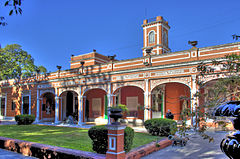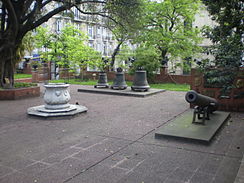- National Historical Museum (Argentina)
-
Museo Histórico Nacional 
Established May 24, 1889 Location 1600 Defensa Street
Buenos Aires, ArgentinaDirector Dr. José Antonio Perez Gollán Website cultura.gov.ar National Historic Monument of ArgentinaThe Argentine National Historical Museum (Spanish: Museo Histórico Nacional) is located in Buenos Aires, Argentina, and is a museum dedicated to the history of Argentina, exhibiting objects relating to the May Revolution and the Argentine War of Independence.
History
The institution was established as the Museo Histórico de la Capital (Historical Museum of the Capital) by Mayor Francisco Seeber on May 24, 1889.
The museum resulted from a proposal by historian Adolfo Carranza, who was designated director of the museum upon its inauguration on February 15, 1891. The museum was initially located on government property located at 3951 Santa Fe Avenue (now occupied by the Buenos Aires Botanical Garden). It was relocated to its present location in the San Telmo ward after the land's purchase by the Municipality of Buenos Aires in 1897. The land later occupied by the Botanical Garden was thus transferred to the municipal government, and the museum to the national government.
The mansion was originally built for the American businessman Charles Ridgley Horne in 1846. Allied to the paramount Governor of Buenos Aires, Juan Manuel de Rosas, Ridgley Horne was forced into exile after the strongman's 1852 overthrow, and the land was sold to José Gregorio Lezama. Following his 1894 death, his widow, Ángela Álzaga de Lezama sold the property to the city, which converted the mansion into the museum, and most of the surrounding land into Lezama Park.
The museum houses over 50,000 items. Portions of the collection were gathered from donations of relatives of important figures in the May Revolution and the wars of independence. Other objects were part of the collection of the Public Museum (Museo Público) created in 1822 by Bernardino Rivadavia. Its displays include regalia, belongings, furnishings and documents belonging to José de San Martín, María de los Remedios de Escalada, Manuel Belgrano, William Carr Beresford, Juan Manuel de Rosas, Bartolomé Mitre, Juan and Eva Perón, and other Argentine, as well as foreign, statesmen, lawmakers, and military figures who played key roles in the nation's history. Its collection of history paintings includes works by Esteban Echeverría, Cándido López and Prilidiano Pueyrredón, among others.
External links
- Virtual visit
- Official website (Spanish)
Coordinates: 34°37′37″S 58°22′14″W / 34.62694°S 58.37056°W
Landmarks of Buenos Aires Note: "Buenos Aires" denotes the city of Buenos Aires proper, not the entire Greater Buenos Aires metropolitan area.Public
& historic buildings
and structuresArgentine Congress · Torre Monumental · Cabildo · Café Tortoni · Casa Rosada · Central Post Office · City Hall · City Legislature · Customs House · Duhau Palace · Estrugamou Building · Floralis Genérica · Galerías Pacífico · Hotel de Inmigrantes · Kavanagh building · Libertador Building · Metropolitan Cathedral · Monument to Giuseppe Garibaldi · Obelisk of Buenos Aires · Palacio Barolo · May Pyramid · Pizzurno Palace · Plaza Hotel · Recoleta Cemetery · San Martín Palace · Sarmiento Frigate · Uruguay Corvette · The Water Company Palace · Women's BridgePrecincts
& neighbourhoodsAlmagro · Belgrano · Buenos Aires CBD · Caballito · City Centre · Colegiales · Montserrat · Núñez · Palermo · Puerto Madero · Recoleta · Retiro · San TelmoNature and parks Avellaneda Park · Botanical gardens · Buenos Aires Ecological Reserve · Chacabuco Park · Congressional Plaza · Japanese Gardens · Lezama Park · Palermo gardens · Plaza de la República · Plaza de Mayo · Plaza San Martín · Parque Centenario · Buenos Aires ZooCultural
InstitutionsEl Ateneo Bookstore · Argentine Automobile Club · Bernardino Rivadavia Natural Sciences Museum · Buenos Aires Museum of Modern Art · Café Tortoni · Fortabat Art Collection · House of Culture · Illuminated Block · Isaac Fernández Blanco Museum · King Fahd Cultural Center · Latin American Art Museum · Museum of Foreign Debt · National Library · National Museum of Decorative Arts · National Museum of Fine Arts · National Museum of History · Opera House · Paz Palace · Planetarium · Recoleta Cultural Center · San Martín Cultural Center · San Martín National Institute · Sarmiento Museum · Eduardo Sívori MuseumSport Bombonera Stadium · River Plate Stadium · Ducó Stadium · Maradona Stadium · Vélez Sársfield Stadium · Argentine Hippodrome of Palermo · Lawn Tennis Club · Polo Stadium · Race Circuit · Arena Obras Sanitarias · CeNARD · Estadio Ricardo EtcheverryTransportation Shopping
& entertainmentAbasto Mall · Avenida Theatre · Cervantes Theatre · Fishermen's Pier · Galerías Pacífico · Gran Rex Theatre · Luna Park Arena · Paseo La Plaza · Patio Bullrich · Opera Theatre · Parque de la Ciudad · La Trastienda ClubStreets
& avenues9 de Julio Avenue · Avenida Alvear · Avenida de Mayo · Avenida del Libertador · Callao Avenue · Caminito · Córdoba Avenue · Coronel Díaz Street · Corrientes Avenue · Figueroa Alcorta Avenue · Florida Street · General Paz Avenue · Leandro Alem Avenue · President Roque Sáenz Peña Avenue · Rivadavia Avenue · Santa Fe Avenue · Scalabrini Ortiz AvenueCategories:- National museums of Argentina
- Museums in Buenos Aires
- History museums in Argentina
- Buildings and structures completed in 1846
- Museums established in 1889
Wikimedia Foundation. 2010.

